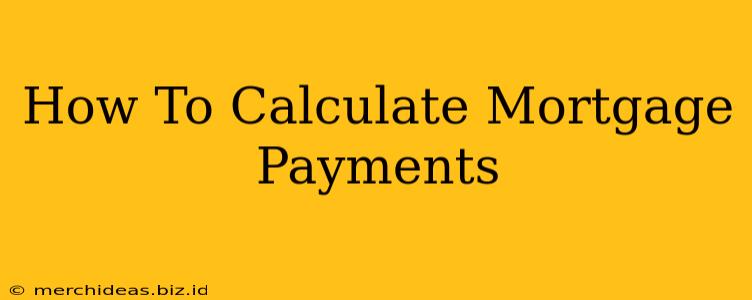Buying a home is a significant financial undertaking, and understanding your mortgage payments is crucial. Knowing how much you'll pay each month will help you budget effectively and avoid financial strain. This guide will walk you through several methods for calculating your mortgage payments, from simple estimations to using online calculators and formulas.
Understanding the Components of Your Mortgage Payment
Before diving into the calculations, let's break down what makes up your monthly mortgage payment:
- Principal: This is the actual loan amount you borrowed to purchase the home.
- Interest: The cost of borrowing money. This is usually calculated as a percentage of the remaining principal balance.
- Property Taxes: These are local taxes levied on your property's value.
- Homeowners Insurance: This protects your home from damage and liability.
- Private Mortgage Insurance (PMI): If your down payment is less than 20% of the home's purchase price, you'll likely be required to pay PMI.
Your total monthly payment is the sum of these components.
Methods for Calculating Your Mortgage Payment
There are several ways to calculate your mortgage payment:
1. Using an Online Mortgage Calculator
The easiest method is to use an online mortgage calculator. Many reputable websites offer free calculators. Simply input the following information:
- Loan Amount: The total amount you're borrowing.
- Interest Rate: The annual interest rate on your loan.
- Loan Term: The length of your loan in years (e.g., 15, 30).
Most calculators will also let you add property taxes and homeowners insurance to get a more complete picture of your monthly expenses. This is the quickest and most convenient method for most people.
2. Using the Amortization Formula
For a more precise calculation, you can use the following amortization formula:
M = P [ i(1 + i)^n ] / [ (1 + i)^n – 1]
Where:
- M = Monthly mortgage payment
- P = Principal loan amount
- i = Monthly interest rate (annual interest rate divided by 12)
- n = Total number of payments (loan term in years multiplied by 12)
This formula can be a bit complex, but it provides a highly accurate calculation. You can use a spreadsheet program or calculator to perform the calculations. Remember to convert the annual interest rate to a monthly rate.
3. Estimating Your Payment
For a rough estimate, you can use a simple rule of thumb: your monthly payment will be roughly 1% of the loan amount for each $100,000 borrowed. For example, a $300,000 loan would have an approximate monthly payment of $3,000 (3 x $1,000). This is just an estimate and does not account for interest or other fees.
Factors Affecting Your Mortgage Payment
Several factors influence your monthly mortgage payment:
- Interest Rates: Higher interest rates result in higher payments.
- Loan Term: Longer loan terms result in lower monthly payments but higher overall interest paid.
- Down Payment: A larger down payment reduces the loan amount and may eliminate PMI.
- Property Taxes and Insurance: These costs vary by location and coverage.
Beyond the Monthly Payment: Understanding the Total Cost
It's essential to remember that your monthly payment is only one part of the equation. Over the life of your loan, you'll pay significantly more than the principal amount due to accumulated interest. Consider using an amortization schedule to see how much of each payment goes toward principal versus interest. This will help you understand the total cost of your mortgage over time.
By understanding these different methods and factors, you can confidently calculate your mortgage payments and make informed decisions about homeownership. Remember to consult with a financial professional for personalized advice.
